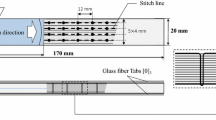Abstract
The focus of the present paper is on the mode-II (shear mode) interlaminar fracture of laminated composite materials with randomly distributed defects such as those generated due to the manufacturing process. The study is conducted using cohesive-zone Finite Element (FE) models of the Interlaminar Shear (ILS) and the End Notch Flexure (ENF) geometries with explicit inclusion of defects on a representative interlaminar plane. The effective interlaminar shear strength and the effective mode-II fracture energy are obtained by comparing the FE analysis with explicit defects against corresponding homogeneous models. Based on the parametric FE results it was found that the effective ILS strength and the mode-II fracture energy are significantly affected by the defects present on the critical interlaminar fracture plane, and when the defects are small, they follow a linear scaling with the defect area fraction. Simulations with various defect sizes reveal that for defects larger than the size of the delamination process-zone, the concept of the effective ILS strength and effective mode-II fracture energy is not valid, and defects must be represented explicitly in the models.

















Similar content being viewed by others
References
Abaqus (2018) Abaqus Version 2018, Dassault Systemes Simulia Corp., Johnston, RI, USA
ASTM D2344/D2344M-16 (2016) Standard Test Method for Short-Beam Strength of Polymer Matrix Composite Materials and Their Laminates, ASTM International, West Conshohocken
ASTM C1292-16 (2016) Standard test method for shear strength of continuous fiber-reinforced advanced ceramics at ambient temperatures. ASTM International, West Conshohocken
ASTM D7905/D7905M-19e1 (2019) Standard test method for determination of the mode II interlaminar fracture toughness of unidirectional fiber-reinforced polymer matrix composites. ASTM International, W. Conshohocken
Chadegani A, Batra RC (2011) Analysis of adhesive-bonded single-lap joint with an interfacial crack and a void. Int J Adhes Adhesives 31:455–465
de Moura MFSF, Daniaud R, Magalhaes AG (2006) Simulation of mechanical behavior of bonded joints containing strip defects. Int J Adhes Adhesives 26:464–473
Dong J, Gong Y (2018) Influence of void defects on progressive tensile damage of three-dimensional braided composites. J Compos Mater 52:2033–2045
Goldberg RK, Bonacuse PJ, Mital SK (2012) Investigation of effects of material architecture on the elastic response of a woven ceramic matrix composite, NASA/TM-2012-217269
Gowayed Y, Ojard G, Prevost E, Santhosh U, Jefferson G (2013) Defects in ceramic matrix composites and their impact on elastic properties. Composite B 55:167–175
Gurdal Z, Tomasino AP, Biggers SB (1991) Effects of processing induced defects on laminate response: interlaminar tensile strength. SAMPE J 27:39–49
Hashemi S, Kinloch AJ, Williams JG (1990) Analysis of interlaminar fracture in uniaxial fibre-polymer composites. Proc R Soc Lond A 427:173–199
Huang H, Talreja R (2005) Effects of void geometry on elastic properties of unidirectional fiber reinforced composites. Comp Sci Tech 65:1964–1981
Kumar RS (2013) Analysis of coupled ply damage and delamination failure processes in ceramic matrix composites. Acta Mater 61:3535–3548
Kumar RS (2021a) Effects of randomly distributed defects on mode-I interlaminar fracture of composite materials. Eng Fract Mech 248:107699
Kumar RS (2021b) Micromechanics approach for the overall elastic properties of ceramic matrix composites incorporating defect structures. ASME J Gas Turb Power. https://doi.org/10.1115/GT2020-16056
Kumar RS, Welsh GS (2012) Delamination failure in ceramic matrix composites: numerical predictions and experiments. Acta Mater 60:2886–2900
Nagaraja A, Gururaja S (2020) Effect of chemical vapor infiltration induced matrix porosity on the mechanical behavior of ceramic matrix minicomposites. ASCE ASME J Risk Uncertain Eng Syst Part B 6:041005-1–41015
Needleman A (1990) An analysis of decohesion along an imperfect interface. Int J Fract 42:21–40
Nikishkov Y, Seon G, Makeev A (2014) Structural analysis of composites with porosity defects based on X-ray computed tomography. J Compos Mater 48:2131–2144
Ricotta M, Quaresimin M, Talreja R (2008) Mode I strain energy release rate in composite laminates in the presence of voids. Compos Sci Tech 68:2616–2623
Santhosh U, Gowayed Y, Ojard G, Smyth I, Kalarikkal S, Jefferson G (2018) Quantification of porosity in ceramic matrix composites using thermography. J Nondestruct Eval 37:37
Talreja R. (2020) Manufacturing defects in composites and their effects on performance. In: Irving P, Soutis C (eds) Polymer composites in the aerospace industry, 2nd edn. Woodhead Publishing, Sawston, pp 83–97. https://doi.org/10.1016/B978-0-08-102679-3.00004-6
Tavaf V, Mohammadsadegh S, Banerjee S (2019) Quantification of degraded constitutive coefficients of composites in the presence of distributed defects. J Compos Mater 53:2517–2529
Turon A, Davila CG, Camanho PP, Costa J (2007) An engineering solution for mesh size effects in the simulation of delamination using cohesive zone models. Eng Fract Mech 74:1665–1682
Acknowledgements
The work reported in this paper was partially funded by the US Air Force Research Laboratory (AFRL) under contract #FA8650-13-C-5213 (Dr. George Jefferson, program monitor). The paper has been approved for public release by the AFRL (Case # AFRL-2021-0933) and Raytheon Technologies Research Center.
Author information
Authors and Affiliations
Corresponding author
Additional information
Publisher's Note
Springer Nature remains neutral with regard to jurisdictional claims in published maps and institutional affiliations.
Rights and permissions
About this article
Cite this article
Kumar, R.S. Mode-II interlaminar fracture of composite materials in the presence of randomly distributed defects. Int J Fract 231, 201–221 (2021). https://doi.org/10.1007/s10704-021-00581-4
Received:
Accepted:
Published:
Issue Date:
DOI: https://doi.org/10.1007/s10704-021-00581-4




